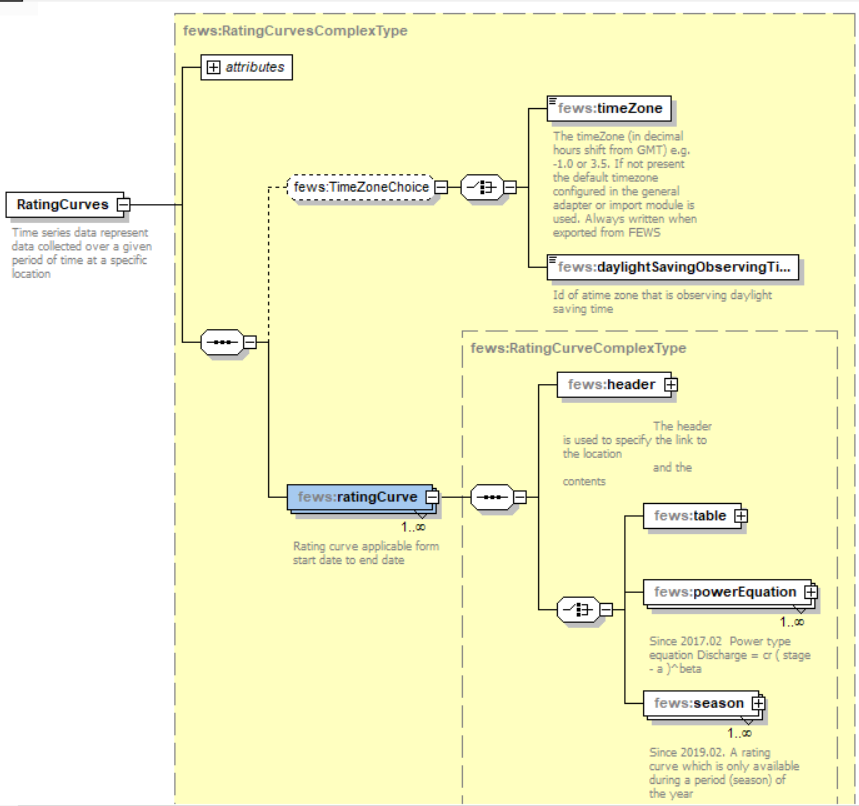...
The transformation stageDischarge/ratingCurve uses rating curves according to the schema pi-ratingcurves.xsd. It is possible to store the ratingcurves in a ratingCurves.xml file in the regionConfig directory. However it is recommended to store the store the ratingCurves to in the FEWS database as time series. The ratingCurves can be imported in the FEWS database by using a dedicated import which is capable of importing rating curves from file as long as the file is compliant with the pi-ratingCurves.xsd schema.
Rating Curve schema
Below an overview of the The schema of the pi-ratingcurves can be found at: http://fews.wldelft.nl/schemas/version1.0/pi-schemas/pi_ratingcurves.xsd
Header
The header element contains the metadata about the rating curve. Below an overview of the available elements.
- locationId
...
- : The location id for which the rating curve is valid
- qualifierId
...
- : The allows the configurator to add 1 or more qualifier to the definition of the rating curve. This is useful when for 1 location more rating curves are valid.
...
- The locationId and the configured qualifiers define the id of the rating curve.
- startDate
...
- : This element defines when the rating curve becomes active.
- endDate
...
- : This (optional) element defines until when the rating curve is active.
- longName
...
- : Optional descriptive name
- stationName
...
- : Optional station name
- stageUnit
...
- : Definition of the stage unit
- dischargeUnit
...
- : Definition of the discharge unit
- comment
...
- : This section allows to define a (optional comment) for the rating curve. If a comment is defined the comment will be shown in the TimeSeriesDialog when viewing the rating curve.
- creationDate
...
- : The date on which the rating curve was created.
- creationTime
...
- : The time on which the rating curve was created.
- region
...
- : The description of the region. This is needed when the id of the rating curve is the same in different regions.
Table
The table contains the actual description of the Table rating curve.
- InterpolationMethod
...
- : Two options are available:linear and logaritmic. When linear is selected the calculation is done by the regular linear method.
The slope will be computed as:
THe The discharge can be calcuted from the stage by using the following equation:
...
This option is usually used to limit the stage value calculated when using extrapolation.
maxStage
The maximum stage which is allowed for this rating curve.
...
If a row doesn't include an offset element then the previous defined offset will be used.
powerEquation (Since 2017.02)
A Power rating cuve function can be used as PI Rating Cuve since Delft-FEWS version 2018.02. The parameters of this power rating curve are a bit different from the standard Power Delft-FEWS rating curve configured in the Region configuration.
The Power Equation is using the equation: discharge = cr * (stage - alpha)^ beta
where ‘cr’ and ‘beta’ are rating curve constants, and ‘alpha’ is a constant which represents the stage corresponding to zero discharge.
To show the stageToDischargePowerEquation rating curves in the TimeSeriesDisplay, a table is generated on the fly from the power equations.
For each equation ten stage values are generated using increment (max stage – min stage) /10 , and for each stage a discharge is computed. Please note that this table is only used in the display and not in TransformationModule computations.
| Code Block | ||||
|---|---|---|---|---|
| ||||


